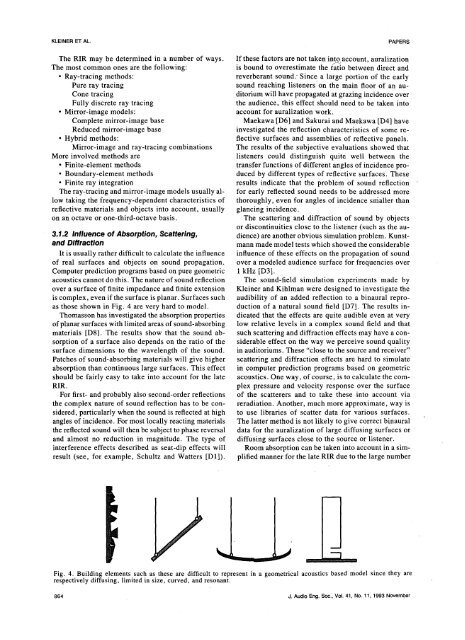Auralization An Overview* - Matt Montag
Auralization An Overview* - Matt Montag
Auralization An Overview* - Matt Montag
Create successful ePaper yourself
Turn your PDF publications into a flip-book with our unique Google optimized e-Paper software.
KLEINERETAL. PAPERS<br />
The RIR may be determined in a number of ways. If these factors are not taken intoaccount, auralization<br />
The most common ones are the following: is bound to overestimate the ratm between direct and<br />
· Ray-tracing methods: reverberant sound.' Since a large portion of the early<br />
Pure ray tracing sound reaching listeners'on the main floor of an au-<br />
Cone tracing ditoriumwill have propagated at grazing incidenceover<br />
Fully discrete ray tracing the audience, this effect should need to be taken into<br />
· Mirror-image models: account for auralization work.<br />
Complete mirror-image base Maekawa [D6] and Sakurai and Maekawa ID4] have<br />
Reduced mirror-image base investigated the reflection characteristics of some re-<br />
. Hybrid methods: flective surfaces and assemblies of reflective panels.<br />
Mirror-image and ray-tracing combinations The results of the subjective evaluations showed that<br />
More involved methods are listeners could distinguish quite well between the<br />
· Finite-element methods transfer functions of different angles of incidence pro-<br />
. Boundary-element methods duced by different types of reflective surfaces. These<br />
· Finite ray integration results indicate that the problem of sound reflection<br />
The ray-tracing and mirror-image models usually al- for early reflected sound needs to be addressed more<br />
low taking the frequency-dependent characteristics of thoroughly, even for angles of incidence srdaller than<br />
reflective materials and objects into account, usually glancing incidence.<br />
on an octave or one-third-octave basis. The scattering and diffraction of sound by objects<br />
or discontinuities close to the listener (such as the au-<br />
3.1.2 Influence of Absorption, Scattering, dience) are another obvious simulation problem. Kunstand<br />
Diffraction mann made model tests which showed the considerable<br />
It is usually rather difficult to calculate the influence influence of these effects on the propagation of sound<br />
of real surfaces and objects on sound propagation, over a modeled audience surface for frequencies over<br />
Computer prediction programs based on pure geometric I kHz [D3].<br />
acoustics cannot do this. The nature of sound reflection The sound-field simulation experiments made by<br />
over a surface of finite impedance and finite extension Kleiner and Kihlman were designed to investigate the<br />
is complex, even if the surface is planar. Surfaces such audibility of an added reflection to a binaural reproas<br />
those shown in Fig. 4 are very hard to model, duction of a natural sound field [D7]. The results in-<br />
Thomasson has investigated the absorption properties dicated that the effects are quite audible even at very<br />
of planar surfaces with limited areas of sound-absorbing low relative levels in a complex sound field and that<br />
materials [D8]. The results show that the sound ab- such scattering and diffraction effects may have a consorption<br />
of a surface also depends on the ratio of the siderable effect on the way we perceive sound quality<br />
surface dimensions to the wavelength of the sound, in auditoriums. These "close to the source and receiver"<br />
Patches of sound-absorbing materials will give higher scattering and diffraction effects are hard to simulate<br />
absorption than continuous large surfaces. This effect in computer prediction programs based on geometric<br />
should be fairly easy to take into account for the late acoustics. One way, of course, is to calculate the com-<br />
RIR. plex pressureand velocityresponseover the surface<br />
For first-and probably also second-order reflections of the scatterers and to take these into account via<br />
the complex nature of sound reflection has to be con- reradiation. <strong>An</strong>other, much more approximate, way is<br />
sidered, particularly when the sound is reflected at high to use libraries of scatter data for various surfaces.<br />
angles of incidence. For most locally reacting materials The latter method is not likely to give correct binaural<br />
the reflected sound will then be subject to phase reversal data for the auralization of large diffusing surfaces or<br />
and almost no reduction in magnitude. The type of diffusing surfaces close to the source or listener.<br />
interference effects described as seat-dip effects will Room absorption can be taken into account in a simresult<br />
(see, for example, Schultz and Waiters [D1]). plified manner for the late RIR due to the large number<br />
Fig. 4. Building elements such as these are difficult to represent in a geometrical acoustics based model since they are<br />
respectively diffusing, limited in size, curved, and resonant.<br />
864 J.AudioEng.Soc.,Vol.41,No.11,1993November


